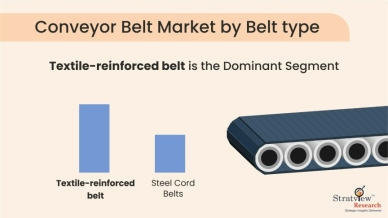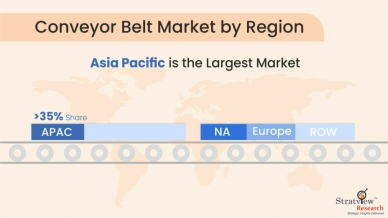Market Dynamics
Introduction
A conveyor belt is a type of material handling equipment that is used in industrial facilities to deliver supplies, materials, and components quickly and easily. It is made of rubber or plastic materials, such as nylon fabric, polyester, styrene-butadiene rubber, and polyvinyl chloride (PVC). These materials enhance the quality of the process, consume less power, are cost-effective, and offer versatility.
Conveyor belt also saves time and space. Many manufacturers are now offering customized conveyor belts in various widths and shapes to meet the needs of end-users in several industry verticals, including healthcare, aviation, and construction.
The conveyor belt mechanism must be maintained to avoid a partial or complete stoppage. However, regular audits and inspections can help reduce the cost of maintenance and repairs over time. A wide range of industries worldwide relies on the availability of various minerals and commodities. Almost all end-use industries require high-performance conveyor belt systems to move goods from one location to another.
Covid-19 Impact
The pandemic disrupted the operations of several industries around the world. Lockdown measures implemented in various countries to control the spread of the COVID-19 pandemic harmed several businesses. The conveyor belt market also could not escape from such trends and witnessed a decline (-8%+ in 2020) amid the pandemic.
Market Drivers
The conveyor belt market growth is most likely to be driven by the expansion of factories, warehouses, and assembly lines in the coming years.
Furthermore, rising cement demand as a result of rapid infrastructure development and urbanization projects in emerging economies such as China and India, as well as the Indian government's target of developing 100 smart cities and metro projects in the coming years, is expected to drive the demand for conveyor belt systems.
Recent Market JVs and Acquisitions:
- In 2018, Michelin Group acquired Fenner PLC to enhance its portfolio for its mining customers.
- Recently, ContiTech USA Inc. acquired 100% of the shares in WCCO Belting LLC to strengthen its position and portfolio in the conveyor belt market.
Segments Analysis
|
Segmentations
|
List of Sub-Segments
|
Dominant and Fastest-Growing Segments
|
|
Belt-Type Analysis
|
Textile-Reinforced Belts, Steel Cord Belts, and Others
|
Textile reinforced belt type is dominant but continues to lose share to steel cords in the coming years.
|
|
Product-Type Analysis
|
Flat Belts, Modular Belts, Cleated Belts, and Other Belts
|
Flat belts are estimated to remain the dominant product type till 2028.
|
|
Weight-Type Analysis
|
Lightweight Belts, Medium-Weight Belts, and Heavy-Weight Belts
|
The medium-weight belt is to be the most widely used weight type in the foreseeable future as it can be used in various industries.
|
|
End-Use Industry -Type Analysis
|
Mining, Food & Beverages, General Manufacturing, Power Generation, Construction & Aggregates, and Others
|
General manufacturing is to register the fastest growth and mining is to continue losing share in the coming years.
|
|
Regional Analysis
|
North America, Europe, Asia-Pacific, and the Rest of the World.
|
Asia-Pacific is to remain the fastest-growing region till 2028.
|
By Belt Type
“The textile reinforced belt type is dominant but continues to lose share to steel cords in the coming years."
The market is segmented into textile-reinforced belts, steel cord belts, and others. The textile-reinforced belt is expected to remain the largest as well as the fastest-growing belt type in the market during the forecast period, mainly driven by its lower cost. Textile reinforcements are ideal for use in most applications because they offer a good balance of cost and strength.
However, through 2022, the demand for rubber conveyor belts with steel cord reinforcement is likely to grow more quickly, mostly due to an increase in global mining output and increasing exploration activities in new mines. In mining applications, steel cord belts are generally selected because of their higher impact resistance. Value growth will also be aided by higher raw material expenses brought on by anticipated rises in steel prices.

Want to get more details about the segmentations? Register Here
By Product Type
“Flat belts are estimated to remain the dominant product type till 2028.”
The market is segmented into flat belts, modular belts, cleated belts, and others. Flat belt is expected to remain the dominant product type in the market during the forecast period. Flat belts are the best viable option for many industrial applications.
They are used to transport lighter products, such as consumer goods and food items, as well as medium- to heavy-weight materials in mining, quarrying, cement making, stone crushing, etc.
By Weight Type
“The medium-weight belt is to be the most widely used weight type in the foreseeable future.”
The market is segmented into lightweight, medium-weight, and heavy-weight belts. The medium-weight belt is expected to remain the dominant weight type in the market during the forecast period, owing to its wider usage in various end-use industries.
Medium-weight belts can be used in various applications as they can sustain heavy weights with fewer complications.
By End-Use Industry Type
“General manufacturing is to register the fastest growth, and mining is to continue losing share in the coming years.”
The market is segmented into mining, general manufacturing, food & beverage, construction & aggregates, power generation, and others. Mining is expected to remain the biggest demand generator of conveyor belts during the forecast period, owing to the wide usage of conveyor belt mechanisms in the mining industry.
On the other hand, the sales of rubber conveyor belts are likely to increase as a result of the expected rise in mining activities, which are mostly due to ongoing economic expansion in developing nations. Conveyor belts are widely used in coal-fired power stations, therefore a global transition away from these facilities will reduce chances for new demand. Some industrialized nations want to entirely stop using coal as a source of energy, which is again a major barrier for this market segment in those nations.
Regional Insights
“Asia-Pacific is expected to remain the largest market for conveyor belts during the forecast period.”
The market is divided geographically into North America, Europe, Asia-Pacific, and the Rest of the World (RoW). Regarding regions, Asia-Pacific is expected to remain the largest market for conveyor belts during the forecast period.
The region is also likely to grow faster during the same period. Its growth factors can be linked to rapid industrialization and its rapidly growing economies.

Want to know which region offers the best growth opportunities? Register Here
Key Players
The market is highly populated with the presence of several local, regional, and global players. Most of the major players compete in some of the governing factors including price, product offerings, regional presence, etc.
The following are the key players in the Conveyor Belt Market (arranged alphabetically)
- Ammeraal Beltech
- Bando Chemical Industries, Ltd.
- ContiTech AG
- Forbo Holding Ltd.
- Mitsuboshi Belting Ltd.
- Semperit AG Holding
- The Yokohama Rubber Co., Ltd.
- Wuxi Baotong Technology Co., Ltd.
- Zhejiang Double Arrow Rubber Co., Ltd
- Zhejiang Sanwei Rubber Item Co., Ltd.
Note: The above list does not necessarily include all the top players in the market.
Are you the leading player in this market? We would love to include your name. Write to us at [email protected]

